
-
 Afrikaans
Afrikaans -
 Albanian
Albanian -
 Amharic
Amharic -
 Arabic
Arabic -
 Armenian
Armenian -
 Azerbaijani
Azerbaijani -
 Basque
Basque -
 Belarusian
Belarusian -
 Bengali
Bengali -
 Bosnian
Bosnian -
 Bulgarian
Bulgarian -
 Catalan
Catalan -
 Cebuano
Cebuano -
 Corsican
Corsican -
 Croatian
Croatian -
 Czech
Czech -
 Danish
Danish -
 Dutch
Dutch -
 English
English -
 Esperanto
Esperanto -
 Estonian
Estonian -
 Finnish
Finnish -
 French
French -
 Frisian
Frisian -
 Galician
Galician -
 Georgian
Georgian -
 German
German -
 Greek
Greek -
 Gujarati
Gujarati -
 Haitian Creole
Haitian Creole -
 hausa
hausa -
 hawaiian
hawaiian -
 Hebrew
Hebrew -
 Hindi
Hindi -
 Miao
Miao -
 Hungarian
Hungarian -
 Icelandic
Icelandic -
 igbo
igbo -
 Indonesian
Indonesian -
 irish
irish -
 Italian
Italian -
 Japanese
Japanese -
 Javanese
Javanese -
 Kannada
Kannada -
 kazakh
kazakh -
 Khmer
Khmer -
 Rwandese
Rwandese -
 Korean
Korean -
 Kurdish
Kurdish -
 Kyrgyz
Kyrgyz -
 Lao
Lao -
 Latin
Latin -
 Latvian
Latvian -
 Lithuanian
Lithuanian -
 Luxembourgish
Luxembourgish -
 Macedonian
Macedonian -
 Malgashi
Malgashi -
 Malay
Malay -
 Malayalam
Malayalam -
 Maltese
Maltese -
 Maori
Maori -
 Marathi
Marathi -
 Mongolian
Mongolian -
 Myanmar
Myanmar -
 Nepali
Nepali -
 Norwegian
Norwegian -
 Norwegian
Norwegian -
 Occitan
Occitan -
 Pashto
Pashto -
 Persian
Persian -
 Polish
Polish -
 Portuguese
Portuguese -
 Punjabi
Punjabi -
 Romanian
Romanian -
 Russian
Russian -
 Samoan
Samoan -
 Scottish Gaelic
Scottish Gaelic -
 Serbian
Serbian -
 Sesotho
Sesotho -
 Shona
Shona -
 Sindhi
Sindhi -
 Sinhala
Sinhala -
 Slovak
Slovak -
 Slovenian
Slovenian -
 Somali
Somali -
 Spanish
Spanish -
 Sundanese
Sundanese -
 Swahili
Swahili -
 Swedish
Swedish -
 Tagalog
Tagalog -
 Tajik
Tajik -
 Tamil
Tamil -
 Tatar
Tatar -
 Telugu
Telugu -
 Thai
Thai -
 Turkish
Turkish -
 Turkmen
Turkmen -
 Ukrainian
Ukrainian -
 Urdu
Urdu -
 Uighur
Uighur -
 Uzbek
Uzbek -
 Vietnamese
Vietnamese -
 Welsh
Welsh -
 Bantu
Bantu -
 Yiddish
Yiddish -
 Yoruba
Yoruba -
 Zulu
Zulu
Optimizing Setup Procedures for Thread Rolling Machines to Enhance Production Efficiency and Quality
The Setup of Thread Rolling Machines A Comprehensive Guide
Thread rolling is a cold forming process that manufacturers utilize to create threads on metal fasteners with precision and efficiency. As the demand for high-quality threaded components continues to rise across various industries, understanding the setup of thread rolling machines becomes essential for ensuring optimal performance and product quality. This article delves into the nuanced process of setting up thread rolling machines, highlighting key considerations and best practices.
Understanding Thread Rolling Machines
Thread rolling machines use cylindrical dies to create threads on a workpiece by compressing the material without cutting. This method offers several advantages, including enhanced strength of threads, improved surface finish, and increased production efficiency. The setup process for these machines is critical, as it directly influences the accuracy of the threaded products and the overall productivity of the operation.
Preparing for Setup
Before beginning the setup of a thread rolling machine, operators must ensure that all necessary tools and materials are at hand. This includes the appropriate rolling dies, workpieces, lubrication systems, and safety equipment. It is also crucial to verify that the machine is in good working order and that all components are clean and properly maintained. Any debris or leftover materials from previous operations can lead to defects in the final products.
Step-by-Step Setup Process
1. Selecting the Right Dies The first step in the setup process is to select the correct rolling dies for the desired thread profile. Dies come in various shapes and sizes, tailored to produce specific thread types, such as coarse or fine threads. Operators must refer to engineering specifications for the product being manufactured to ensure compatibility.
thread rolling machine setup product

2. Adjusting Machine Settings Once the dies are selected, the next step involves adjusting the machine settings. This includes setting the gap between the dies to accommodate the diameter of the workpiece and adjusting the rolling pressure. Proper calibration is essential; incorrect pressures may lead to thread deformation or breakage during rolling.
3. Positioning the Workpiece Proper positioning of the workpiece is vital for achieving uniformity in the threaded components. The workpiece should be securely loaded into the machine's feed mechanism, ensuring that it is aligned correctly with the dies. This may involve using fixtures or guides to maintain consistency during the rolling process.
4. Lubrication Lubrication plays a key role in the thread rolling process, reducing friction and minimizing wear on both the dies and the workpieces. Operators should apply the appropriate lubricant according to the material properties and machine specifications, ensuring even distribution throughout the rolling area.
5. Testing the Setup Before commencing full-scale production, it is advisable to conduct trial runs with a few test workpieces. This allows operators to verify that the setup is correct and that the threads produced meet the specified standards. Any necessary adjustments can be made based on the results of these tests.
Continuous Monitoring and Adjustment
Once production begins, continuous monitoring is necessary to ensure that the machine operates smoothly and that the products maintain consistent quality. Operators should routinely check for signs of wear on the dies, monitor lubrication levels, and inspect the threads being produced. Regular feedback loops can help identify any issues early on, preventing waste and ensuring efficiency.
Conclusion
Setting up a thread rolling machine is a crucial process that requires attention to detail, technical knowledge, and experience. By following a structured setup procedure and continually monitoring the operation, manufacturers can achieve high-quality threaded components with improved efficiency. As technology advances, adopting innovations in thread rolling processes will further enhance production capabilities, meeting the growing demands of various industries.
